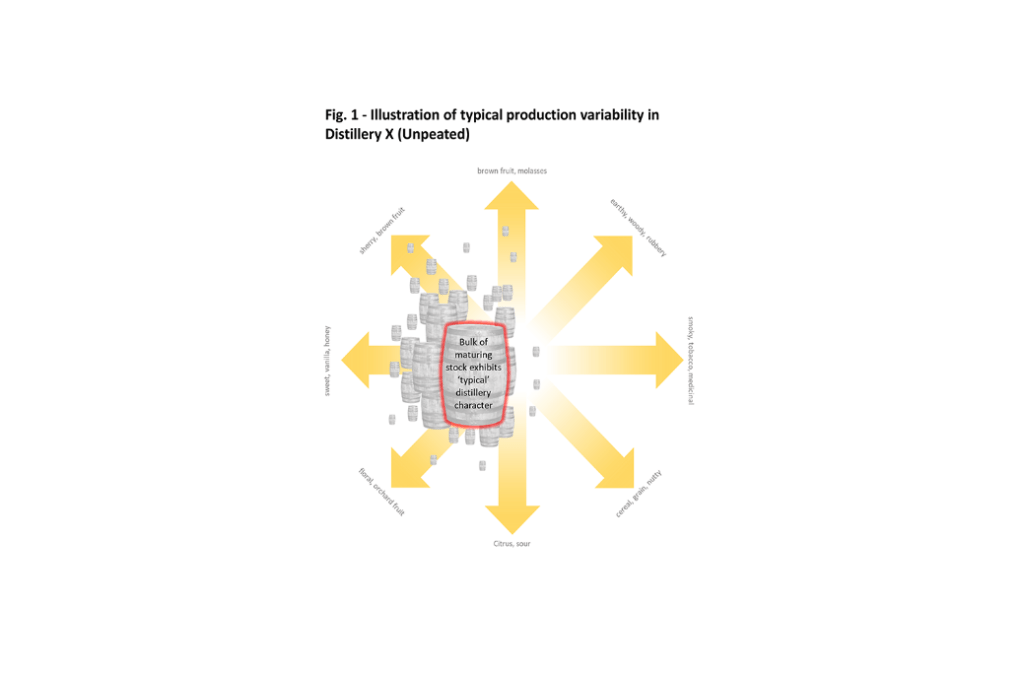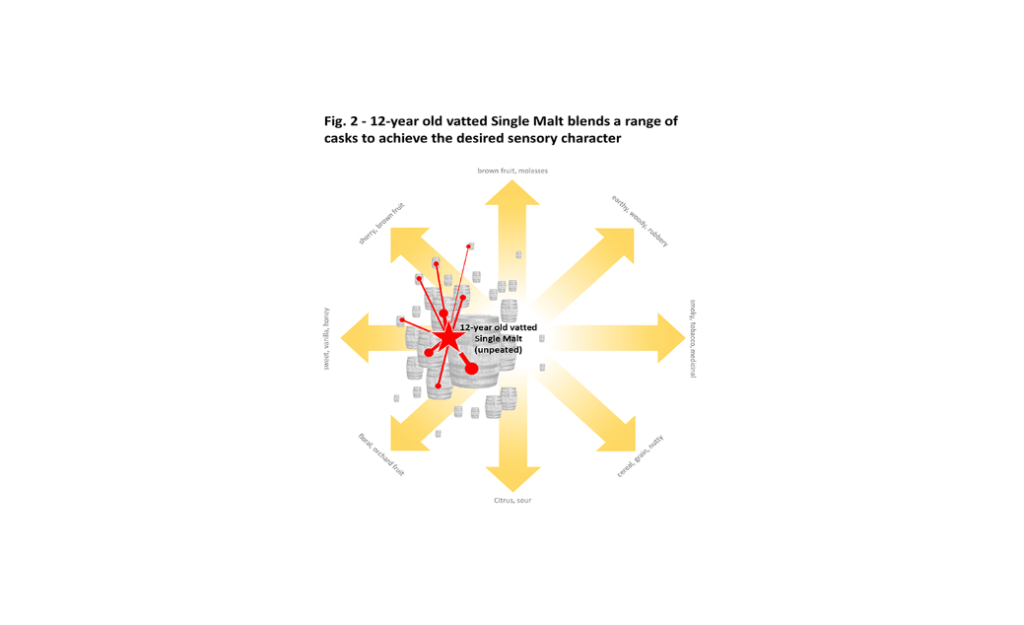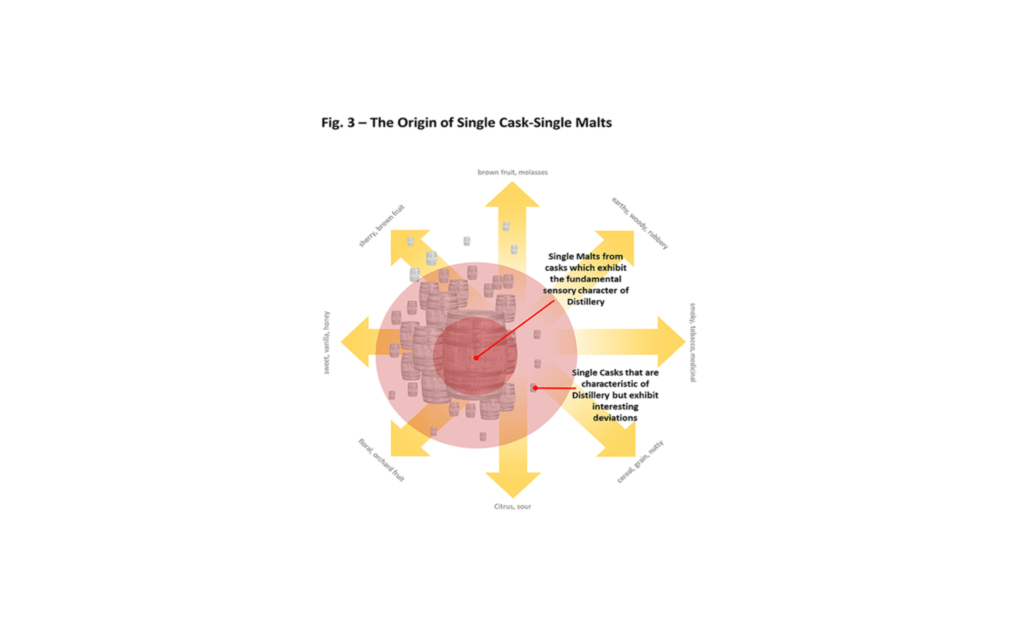Single Cask-Single Malt Scotch Whisky vs Vatted Single Malt Scotch Whisky In this technical note we consider the differences between:
Single Cask-Single Malts – non-chill filtered and bottled at cask strength, typically 55% – 60% ABV (alcohol by volume), as presented in Annandale Distillery’s Man O’Sword and Man O’Words collection.
Vatted Single Malts – chill filtered and bottled at either 40% or 43% ABV, as typically purchased in retail and duty-free shops, bars and restaurants.
To produce Vatted Single Malts, a relatively large number of barrels of mature whisky, all from the same distillery, are blended together in a vat to achieve a flavour profile that’s consistent with consumers’ expectations of that brand. Consequently, every bottle of Glenfiddich 12 year old (for example) should taste essentially the same no matter where and when it’s purchased. Achieving this degree of consistency requires a vast inventory of maturing whisky to select from, and the services of a very skilled whisky blender (more of which later). The age declaration, should there be one, refers to the youngest whisky included in the vatting.
Assuming that the bulk of whiskies in a particular vatting were around 12 years old (again, as an example), it’s likely that the average alcohol content would be approximately 55 ± 2% ABV. To achieve a bottling strength of 40% or 43% ABV, the whisky is diluted with water. Ideally the dilution water would be drawn from the distillery source, although treated mains water is often used instead. There are two principal reasons why Single Malts are diluted to either 40% or 43% ABV prior to bottling:
Economic – the excise duty on a 70cl bottle of 40% ABV Single Malt (£8.04 in the UK) is considerably less than on a 55% ABV cask strength bottling (£11.06). Unsurprisingly, the water used for dilution is much less expensive than whisky. These two factors make 40% ABV Single Malt significantly cheaper than cask strength whisky, allowing it to be accessible to a wider socio-economic group than might otherwise be the case. Sensory – adding water decreases the pungency of the alcohol. This makes it easier to appreciate the underlying sensory characteristics of the whisky and otherwise, less challenging for some consumers.
Making Single Malt Scotch Whisky more accessible in both of these respects has helped the industry to expand enormously over the last 30 – 40 years.
However, there’s a catch! When whisky is diluted below ~46% ABV, it will often become cloudy/hazy if subsequently chilled and diluted in-glass by the further addition of cold water and/or ice. This effect is caused by the clumping together of naturally occurring fatty acids and esters to form insoluble micelles. Cloudiness is considered undesirable by some, if not all, whisky drinkers. To prevent this happening, fatty acids and esters are removed using a process known as chill filtration (see Technical Note on Chill Filtration for further details). Almost all single malts bottled at either 43% or 40% ABV will have been chill filtered. Conversely, those bottled at 46% ABV and above are likely to be non-chill filtered.
Chill filtration is often demonised by whisky aficionados in the belief that it defiles the simple, natural purity of Single Malt Scotch Whisky by unnecessarily removing something of its very essence. In practice, only the largest (longest chain) fatty acids and esters are actually removed and these typically have little or no impact on flavour. Nonetheless, chill filtration is a complete anathema to Single Malt purists. Paradoxically, the emergence of a cloudy haze when cask strength Single Cask-Single Malt is diluted and chilled in-glass, is considered by some to be indicative of its unsullied purity!
With non-chill filtered Single Cask-Single Malts bottled at cask strength, the whisky is simply disgorged from its cask into a tank, passed through a relatively coarse membrane to remove particles of carbon (from the charred inside surface of the cask) and then bottled. Whilst it is permissible to add caramel as a colourant, the colour of a Single Cask-Single Malt usually derives solely from pigments extracted from the oak barrel staves. Nothing is added and nothing is taken away other than carbon particles. This is authentic, unsullied and uncomplicated whisky at its absolute purest! The other defining feature of a Single Cask-Single Malt is the very fact that it derives from just one cask (the clue’s in the name.) As there’s no blending (vatting) of multiple casks to achieve a standardised flavour profile, the flavour of the whisky comes to depend on four factors; the spirit, the cask, the maturation environment (microclimate inside the maturation warehouse) and the length of maturation (i.e. its age). Let’s consider each of these factors in turn: Spirit – most distilleries strive to produce spirit that’s consistent from batch-to-batch, although some extent of seasonal, ingredient and process related variation is inevitable. Whilst this might ultimately affect the flavour profile of the mature whisky, the unique and defining character of the distillery should still be apparent over and above any such background variation.
Casks – it’s a legal requirement that Scotch whisky should be matured in oak casks. However, oak casks aren’t all the same! For example, they may differ in the species of oak used in their construction; principally American versus French/Spanish oak. The more-open grained Southern European oaks permit easier ingression of the spirit into the wood and consequently, more rapid extraction of oak-derived flavour components. The closer-grained American oak (Quercus Alba) is generally considered to be optimal, even for sherry butts coopered in Spain!
The size of the cask, or more precisely the ratio of the inner surface area of the cask to the volume of liquid it contains, influences the interaction between spirit and oak and consequently, flavour development. (Refer to Technical Note on Small Casks for further details).
Almost all of the casks used in the maturation of Scotch Whisky will have been used previously to mature other spirits (principally bourbon but also other American whiskies, cognac, rum and tequila), wines of various types (mainly sherry but also port, madeira and a variety of red and white wines) and even beer. The extent to which the previous occupant impacts on the flavour of the maturing spirit, depends on whether it’s the first time the cask has been used for Scotch Whisky maturation (known as a ‘fresh’, or ‘once-used’ cask) or alternatively, if the cask has been re-used on several occasions (known as a ‘refill’ cask). The more often a cask has been refilled with Scotch Whisky, the less potent the effect of both the oak and the previous occupant and consequently, the longer the maturation time.
Maturation Environment – when the spirit inside a cask warms up due to diurnal and/or seasonal temperature fluctuations, it expands. This increases the pressure inside the cask, causing expulsion of air through the microscopic gaps that exist between cask staves. The expelled air (the angels’ share) comprises a mixture of water vapour, alcohol vapour and various volatile flavour compounds. When the liquid cools it draws air back into the cask through the same gaps. The greater the temperature fluctuations, the greater this effect. It’s not too difficult to imagine that the cool, moist, salt-laden air drawn into casks maturing on the island of Islay, might have a different effect on flavour development versus the drier, less salty and often cooler air inside a Speyside maturation warehouse. And what about Kavalan Distillery on the island of Taiwan, where the average daytime temperature is consistently around 30+oC but the night-time temperature may drop by as much as 20oC.
The practice of transporting bulk spirit from a local distillery and maturing it in a distant, centralised bonded warehouse containing whiskies from other distilleries, inevitably neutralises the effect of the local micro-climate on flavour development. For those who care about the authenticity of their Single Malt, this practice is regrettable, to say the very least!
Length of maturation – it’s a common misconception that older whiskies are ‘better’ than younger whiskies. Whilst immature whisky typically lacks complexity, depth of flavour and balance, and it may even be harsh and insipid, it’s also possible to over-mature whisky by leaving it in-cask for too long. Should this occur, the sensory profile of the whisky will be dominated by flavour components extracted from the cask staves (known as ‘cask effect’). If excessive, this will mask the more subtle distillery-specific sensory characteristics (distinctive distillery character).
The age at which a particular whisky reaches optimum maturity depends on the nature of the spirit (whisky from some distilleries matures faster than others), the type of cask (‘fresh’ casks mature spirit more rapidly than ‘refills’) and the maturation environment.
Also, what constitutes optimum maturity depends on the sensory preferences of individual whisky drinkers (which may be very different). This suggests that maturation should be determined not by age, but by a combination of several key sensory criteria:Presence of… Absence of…
Flavour complexity Excessive cask effect Depth of flavour Harshness Distinctive distillery character
Insipidness Balance
We could describe whiskies that satisfy all of these criteria as having reached ‘sensory maturity’ irrespective of age. This allows for the possibility of ongoing flavour development/change with age, provided that none of these sensory criteria are violated.It also allows for the possibility that the maturing whisky could pass through a sequence of several different sensory optima, the longer it stays in-cask.
For any particular distillery, the nature of the spirit produced and the maturation environment are essentially constants, in so far as the spirit should be consistent and all casks should be subject to more or less the same diurnal and seasonal temperature variations during maturation (although the exact location within the warehouse may affect the ambient temperature in the immediate environs of any particular cask).
Consequently, the principal determinants of flavour variation for a particular distillery are the nature of the maturation cask combined with length of time in-cask (i.e. its age). This implies that the sensory profile of each cask is likely to be unique, to some extent, but still within the ‘universe’ of what constitutes characteristic flavour for that particular distillery. Now for the slightly trickier part!
Let’s imagine that we’re going to plot all of the maturing casks produced by a particular distillery (Distillery X) on a theoretical sensory map (Figure 1), where those casks that are most similar in flavour are located near to each other on the map, and those that are more different are further apart (i.e. the greater the sensory differences in the maturing whisky, the greater the distance apart on the map).

Assuming that Distillery X is producing consistent spirit and maturing it in similar casks of common provenance, we’d expect to find a large and dense cluster of casks located on the map (not necessarily at the centre), with the other casks spread around the outside of the main cluster. Some of these other casks would be clumped together in smaller clusters and some would be singletons.
Of these smaller clusters/singletons, some would be located quite close to the main phalanx, whereas others would be further afield (because their sensory profiles are rather different). A small number of singletons or tiny clusters of casks would also be positioned towards the various extremities of the map (sensory outliers).
Each cask would have a unique identity in terms of date distilled, type of cask/cask provenance and length of time the whisky has been in-cask (i.e. its age). Whilst it might be anticipated that casks of a similar type/provenance, aged for a similar amount of time should produce Single Malts with very similar sensory profiles (and therefore should locate proximally on the map), this is by no means a given. Indeed, part of the mystique of Single Malt production is that spirit produced in the same batch, filled into seemingly identical casks and stored side-by-side in the same bonded warehouse for the same length of time, will sometimes produce noticeably different whiskies.
Let’s now imagine that Distillery X wishes to produce a 12 year old vatted Single Malt at 40% ABV. The first thing to do would be to edit our theoretical sensory map by notionally deleting all of the casks aged for less than 12 years (Figure 2). It might be imagined that the topography of the edited map would still resemble that of the original sensory map, but the size, shape and density of the cask clusters would perhaps change, and some of the outliers would probably disappear.

Inevitably, the character of the vatted 12 year old would be dominated by the sensory characteristics of Single Malts located in the main cluster because these constitute the bulk of the maturing stock. However, rather than including casks drawn solely from the main cluster, the master blender might choose to make the sensory profile of the vatted Single Malt more complex and/or more balanced (for example) by introducing a selection of Single Malts from the more outlying regions of the sensory map. Bearing this in mind, if the sensory profile of this 12 year old vatted Single Malt was subsequently plotted onto the original sensory map, it would perhaps be positioned away from the centre of the main cluster; its location reflecting some of the sensory nuances introduced by the master blender.
If we further imagine that Distillery X also wanted to produce a 16 year old vatted Single Malt, a similar theoretical process could take place. Presumably, the sensory profiles of the 12 and 16 year old vattings would be different so they’d be located somewhat apart on our theoretical sensory map. As part of the vatting process, treated water is added to reduce the alcohol content to either 40% or 43% ABV, prior to chill filtration and bottling.
Does this all sound rather theoretical and far-fetched?
Perhaps it does, but this is essentially what goes on in the mind of the master blender. They hold in their memory, a mental representation of the target sensory profile of the vatted Single Malt, along with mental representations of the universe of sensory profiles of the maturing Single Malts typically produced by Distillery X (i.e. a mental representation of the above mentioned sensory map). On selecting and nosing samples of maturing stock, the master blender will decide whether or not the whisky in each of these casks is suitable for inclusion in the vatting. In doing so, they systematically build-up a mental representation of the vatting that they’re creating, decide what else needs to be added to the blend to achieve the target sensory profile and then they’ll sniff and select appropriate casks from their inventory to finalise the blend. Exactly the same process is used for creating Blended Scotch Whiskies.Although most master blenders can readily describe what they’re doing and why, blending is essentially a non-verbal, non-conscious process (even if the blender might think otherwise). Now you know why master blenders are such ‘rare beasts’, why it takes them so long to train and become proficient and why huge Scotch whisky producers such as Diageo, Chivas Brothers, William Grant, Edrington, Beam Suntory, etc., are all obliged to rely upon just a few amazingly skilled and talented individuals!
But where do Single Cask-Single Malts fit into this picture?
Cast your mind back to the theoretical sensory map of Single Malts from Distillery X (Figure 1). Now delete from the map, all of those casks that have not yet attained sensory maturity (as previously defined). The mission hereafter of the whisky/sensory expert (if not the master blender) is to identify two ‘types’ of Single Cask from the depleted sensory map:1/ Single Malts from casks drawn from the centre of the main cluster (as described above), which exhibit the fundamental sensory character of Distillery X (Figure 3). In practice, these will probably be several-times-used ex-bourbon casks (refills) where the cask effect is somewhat muted, or once-used (fresh) ex-bourbon casks where the Single Malt has reached sensory maturity without exhibiting excessive influence from the oak (or its previous occupant). Obviously, the latter are likely to reach sensory maturity more quickly than the former.
2/ Single Casks that are characteristic of Distillery X but exhibit interesting deviations. These could be ex-bourbon casks of one type or other which, for whatever reason, have delivered a sensorially mature Single Malt that’s outside the main cluster. However, it’s more likely that these will be the product of some less run-of-the-mill casks, as detailed previously. It’s important that these shouldn’t be construed as outlandish, but interesting and slightly more unusual whiskies from within the sensory universe of Distillery X (Figure 3).

At Annandale Distillery we don’t currently produce vatted Single Malts. Whilst we have total respect for Master Blenders and the wonderful blended and vatted Scotch Whiskies that they create, we prefer to select Single Casks that exemplify the unfettered character of our peated or unpeated Annandale Single Malts, or slightly unusual departures from the centre-ground of Annandale’s peated and unpeated sensory maps. We don’t chill filter because there’s no point and we also prefer to bottle our Single Malts at cask strength, allowing the whisky drinker to dilute-to-taste.
Our Rare Vintage 2014 and Vintage 2015 are exemplars of ‘main cluster’ Single Cask-Single Malts whereas our Founders’ Selection range are ‘interesting deviations’ from the main cluster. Indeed, one of the greatest delights that comes from owning a distillery is in sampling and tracking the maturing stock in our bonded warehouses and singling out those casks that satisfy the stringent standards we set for Annandale’s Single Cask-Single Malt bottlings.
As our guarantee of uniqueness and provenance, every bottle of Annandale’s Single Cask-Single Malt is identified by cask number (e.g. 2014/98) and sequential bottle number (e.g. 98 of 236). We hope they’ll delight your senses and your emotions!Single Cask-Single Malt – authentic, unsullied, uncomplicated Scotch Whisky at its absolute purest!
